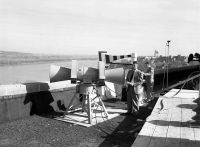Harry O. Ricci Siren & Signal, Inc.
Harry O. Ricci Siren & Signal (H.O.R.) was a siren company based in Staten Island, New York, that built the high-performance Super Sirex and Siro-Drone electric sirens. The company was formed by its namesake, Harry O. Ricci, an Italian immigrant who came to America and saw the potential for success in the competitive outdoor warning siren market during the Cold War. Inspired by designs from Europe, Ricci's sirens became known for their impressive performance and saw widespread use across the United States. However, the company would fall on hard times and cease operations by the late 1960s. Ricci himself never wanted the company to be massively successful, as he preferred not to deal with the pressure of mass-producing his hand-built sirens.
While mentioned in some advertisements, the company's name was never "Hear Our Roar" despite popular misconception.
History
Ricci's company originally began operations in Staten Island, NY around the early 1940s. Advertisements for Ricci's sirens exist from as early as 1942. Ricci quickly found success in the Eastern United States, and over 700 Siro-Drones and 34 Super Sirexes were installed in New York City, as part of the city's civil defense program.
In 1960, H.O.R. moved their headquarters to Phoenix, Arizona, where they installed a large amount of Super Sirexes, to aid the existing system of Federal Signal Thunderbolt 2000 sirens. At least three of these Super Sirexes still exist to this day, two in private possession, and one reinstalled in Adrian, Missouri. Phoenix also had at least one dual tone Sirex, which is currently in private possession.
H.O.R. partnered with another company, Sireno, to produce various vertical sirens using H.O.R. rotor/stator castings. When this was done is up for debate.
Products
Siro-Drone
See article: H.O.R. Siro-Drone
The Siro-Drone began production by as early as 1942 and were H.O.R.'s first successful attempt at making an outdoor warning siren larger than a vehicular siren. The Siro-Drone was advertised as a "roaring" siren and was intended to be a competitor to the Fedelcode (and later Model 5) sirens produced by Federal Electric and later Federal Sign & Signal. The sirens were available in a variety of different horsepower ratings and housing styles, and it is unknown exactly how many different variations there were. The Siro-Drone was available in ⅛ hp, 2 hp, 3 hp, 5 hp, and 7.5 hp. These sirens were available in 1 or 3 ph AC, and could use 7, 9, 10, or 12-port single tone rotors and stators.
Sirex (Si-Rex)
See article: H.O.R. Sirex
The Sirex (sometimes referred to as the Si-Rex) is a vertical, omnidirectional siren that was produced during the 1950s and 1960s, and was a middle ground between the rotational Super Sirex and the smaller vertical Siro-Drones. The Sirex was introduced sometime around 1951, alongside the Super Sirex, and all units were hand-built by Harry O. Ricci and his company. The Sirex is essentially a Super Sirex in vertical, omnidirectional form, using the exact same rotors and stators as the Super Sirex.
Super Sirex (Super Si-Rex)
See article: H.O.R. Super Sirex
The Super Sirex (Also sometimes referred to as the Super Si-Rex) is a line of large sized rotating sirens that was produced throughout the 1950s and 1960s. These sirens boasted incredible volume and range for the time, outperforming many of its contemporaries. Unfortunately few survive in service today due to its age, lack of replacement parts, and reliability issues with its rotators. These rotating behemoths were sometimes called "The Granddaddy Of All Sirens". The Super Sirex was created roughly around 1951 as an attempt to create a high-powered rotating siren for civil defense purposes, as the newly christened Cold War introduced the threat of potential nuclear warfare. H.O.R.'s existing Siro-Drones were simply not powerful enough for this purpose, leading H.O.R. to create the Super Sirex and its omnidirectional vertical cousin the Sirex. The U.S. Government ran trials to look for effective civil defense sirens, with the Super Sirex being introduced alongside other rotational sirens such Federal's Thunderbolt prototypes and BNCO's Mobil Directo.
